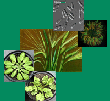| Maier, T; Yu, C; Küllertz, G; Clemens, S: Localization and functional characterization of metal-binding sites in phytochelatin synthases, Planta, 218, 300-308 (2003), doi:10.1007/s00425-003-1091-7 | |
| Abstract: Metal-binding domains consisting of short, contiguous stretches of amino acids are found in many proteins mediating the transport, buffering, trafficking or detoxification of metal ions. Phytochelatin synthases are metal-activated enzymes that function in the detoxification of Cd2+ and other toxic metal and metalloid ions. In order to localize Cd2+-binding sites, peptide libraries of two diverse phytochelatin synthases were synthesized and incubated with 109Cd2+. Distinct binding sites and binding motifs could be localized based on the patterns of Cd2+-binding. The number of binding sites was consistent with previous findings for recombinant protein. Positions of binding sites appeared to be conserved even among diverse phytochelatin synthases. Mutant peptide analysis was used to assess the contribution of exemplary amino acids to binding. Several binding motifs contain cysteines or glutamates. For cysteines a strong correlation was found between binding activity and degree of conservation among known phytochelatin synthases. These findings indicate the suitability of peptide scanning for the identification of metal-binding sites. The functional role of several cysteines was investigated by expression of hemagglutinin-tagged phytochelatin synthases in phytochelatin synthase-deficient, Cd2+-hypersensitive Schizosaccharomyces pombe cells. The data are consistent with a model suggesting functionally essential metal-binding activation sites in the N-terminal catalytic part of phytochelatin synthases and additional binding sites at the C-terminus not essential for activity. |

